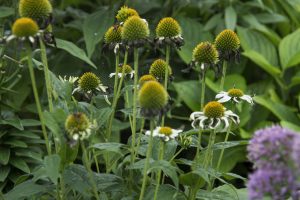
I have under a large cedar tree a perennial rock garden by the shore of Lake Scugog. Plants include: Lilies, Allium, Columbine, Tickseed and several Echinacea in pink, red, white and apricot. For interest I do plant Lobelia. All of the plants thrive.
My question is regarding my white echinacea. For the fourth year it dies back just after blooming. The petals curl and turn black and then it goes to seed. The pink and others thrive in the same conditions. The soil is on the acidic side and is well drained. The garden is in part sun with morning and later afternoon sun. I fertilize monthly with 15-30-15 Miracle Grow.
I am curious as to why only the white plant behaves this way. I cannot see mites or bugs on it and the leaves appear healthy. I purchased it in June 2016 from the same nursery as all the others. It has never performed well. I am considering removing it and replacing it with something else next year unless you may have some possible solutions.
Thank you,
Thank you for contacting the Toronto Master Gardeners with your interesting query.
Echinacea species have a moderate growth rate and will perform best in an area with full sun to part shade. Coneflowers prefer evenly moist, well-drained soils; however, they are drought and heat tolerant once established.
From my research the only possibility that could explain the problem with your white cone flower is Eriophyid mites. Eriophyid mites are unique among other mites both in their size and anatomy. They are undetectable with the naked eye. The coneflower rosette mites live inside the developing flower buds and suck nutrients from the base of the flowers. As a result, green to reddish-green elongated rosette-like tufts of stunted and distorted flower parts will sprout from the tops or sides of the cones of coneflowers. In your photo I can see the start of one of these green tufts starting to sprout on the top of one of your flowers.
Cultural practices, such as proper plant spacing and well-drained soils, and proper sanitation is the key to managing the mite. Cutting and destroying flower heads deformed by mite activity will reduce mite populations.

